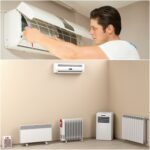Table of Contents
For many reasons, home garage door maintenance is necessary. Along with maintaining the security of your house and family, routine service extends the garage door’s lifespan and ultimately saves you money.
It is essential to provide your garage door with regular maintenance. It maintains your door functioning properly and helps to prevent unplanned malfunctions.
If little problems are not properly maintained, they might grow into larger ones that require expensive repairs or possibly a full replacement.
How to Maintain Your Home Garage Door?
Components of a Home Garage Door
You must understand the functions of your garage door’s major parts to keep it correctly. Garage doors come in various varieties, each with unique features.
1. Types of Garage Doors
- Manual Garage Doors
These doors must be manually opened and closed. Since they are simpler and typically less expensive, they take more physical work to operate.
- Automatic Home Garage Door
With the touch of a button, you can easily open and close these doors because of the electric opener that comes with them. They frequently contain extra safety measures and are more convenient.
2. Key Parts of a Home Garage Door
- Springs
The door’s lifting and lowering are made possible by the springs. They may fail over time due to the extreme strain they are under.
- Rollers
The door is smoothly pushed up and down by the rollers that go along the tracks.
- Tracks
The rails that the door travels on are called tracks. For the doors to operate properly, they must be maintained and positioned correctly.
- Hinges
The hinges allow the door to flex when it opens and closes by joining the various parts of the door.
- Opener
The mechanical mechanism that operates the automated door is called an opener. In case of a power outage, it may have sensors, remote controls, and a manual release.
Read: Home Maintenance Apps and Tools to Simplify Your Life in the USA
Regular Inspection
1. Visual Inspection
- Look for Wear and Tear on Parts
Explore every component of your home garage door, bearing in mind the tracks, hinges, rollers, and springs. Check any worn-out parts, frayed wires, bent or broken pieces, or other indications of wear and tear.
- Check for Rust, Dents, and Damage
Inspect any metal components for rust, as this can damage the door and its parts. Inspect the door panels and tracks for any dents or other damage as well. The functioning of the door may be impacted by rust and damage, which is why it needs to be fixed right away.
2. Operational Check
- Test the Door’s Balance
If you have an automated door opener, unplug it and manually raise the door halfway. The door is balanced if it remains in position. It is necessary to modify the balance if it moves upward or downward.
- Ensure Smooth Opening and Closing
To make sure the door opens and closes smoothly, operate it multiple times. Keep an ear out for any odd sounds, and keep an eye out for jerky motions or uneven performance. These can be indicators of deeper issues that require attention.
Cleaning and Lubrication
1. Cleaning
- Remove Dirt and Debris from Tracks
A buildup of dirt and debris in the tracks over time can make the door less smooth to operate. Wipe down any buildup on the tracks using a moist cloth. A little brush or vacuum might be useful for tough dirt.
- Clean the Door’s Surface
Clean the door’s surface with a moderate detergent and water mixture. This keeps dirt from causing damage to the door and also keeps it looking nice. To stop rust, give it a good rinse with water and pat dry with a fresh cloth.
2. Lubrication
- Lubricate Moving Parts
Keep your garage door’s rollers, hinges, tracks, and springs lubricated on a regular basis. By doing this, wear and friction are decreased, resulting in smoother operation and longer component life.
- Recommended Lubricants
Use a silicone-based spray or premium home garage door lubrication. The use of thick oils or grease is discouraged since it might draw in more filth and debris.
To avoid accumulation, lubricate each moving part sparingly and remove any excess by wiping it away.
Tightening Hardware
To make sure your home garage door operates smoothly and lasts a long time, keep the hardware tightly and secure.
Badly connected bolts, screws, brackets, and hinges can lead to displacement or malfunctioning of the door.
- Bolts and Screws
Bolts and screws may become loose with time due to the home garage door’s continuous movement. Check all of the screws and nuts on the door and its tracks regularly.
Tighten any loose screws with a screwdriver or tool, making sure the screws are snug but not too tight.
- Brackets and Hinges
The most important parts that keep the door in place and enable smooth movement are the brackets and hinges.
Check each bracket that fastens the tracks to the wall or ceiling, as well as the hinges joining the door panels.
Verify that they are firmly attached and do not exhibit any symptoms of degradation. If any hinges or brackets are loose, replace them or tighten them as needed.
Read: Roof Maintenance – How to Extend the Life of Your Roof in the USA
Testing the Home Garage Door Balance
For your home garage door to operate smoothly and safely, it must be balanced.
An imbalanced door may put an additional burden on the opener and other parts, increasing the risk of damage and expensive repairs.
1. How to Perform a Balance Test?
Use these easy methods to check the balance of the home garage door,
- Shut off the garage door entirely.
- By pushing the release handle, you can disconnect the automatic opener.
- Raise the door by hand to around waist height, then release the latch.
- Keep an eye on how the door opens.
- The door is balanced if it remains in position. It is out of equilibrium if it goes up or down.
2. Adjusting the Balance if Necessary
It is usually preferable to hire a professional to adjust your uneven door.
Yet, you can change the spring tension if you feel confident doing it yourself and have experience with home repairs,
- Find the springs; extension springs are normally along the sides of the door, and torsion springs are above it.
- To precisely alter the tension on the torsion springs or the location of the extension springs, use a winding bar.
- Once the door remains in place when raised to waist height, make minor modifications and retest the balance.
Inspect and Replace Weather Stripping
An essential part of your home garage door that keeps the weather and pests out and keeps your garage dry and clean is weather stripping.
1. Importance of Weather Stripping
- Protects Against Elements and Pests
By creating a seal between the home garage door and the ground, weather stripping keeps debris, water, and other elements out of your garage.
Also, it helps in keeping pests like rodents and flies out.
Minimizing drafts and keeping your garage warmer in the winter and colder in the summer, can also increase energy efficiency.
2. How to Inspect and Replace Worn-Out Weather Stripping?
- Inspection
Check the weather stripping on your home garage door sides and bottom regularly. Keep an eye out for wear indicators like cracks, holes, or missing parts. The weatherstripping has to be replaced if it is broken or weak.
- Removal
To get rid of the outdated weather stripping, use a screwdriver or tool knife. With caution to avoid scratching the door’s surface, pull it away from the door.
- Measure and Cut
Cut the new weather stripping to length based on the measured length of the door. Verify that the new strip matches the old one in terms of size and type.
- Installation
Depending on the type of door and weather stripping, slide the new weather stripping into the track or fasten it with screws or nails. To ensure a proper seal, make sure it fits tightly against the door and the ground.
- Test the Seal
Shut the home garage door and look for any openings where air or light could be leaking in. To guarantee a tight seal, adjust the weather stripping as necessary.
Read: Indoor Air Quality – Maintenance Tips for Healthier American Homes
Safety Features and Tests
1. Testing the Auto-Reverse Feature
One safety element that keeps the door from closing on people or objects is the auto-reverse mechanism.
To put it to the test,
- Position a tiny item (like a roll of paper towels) in the way of the door.
- With the door opener, shut the door.
- The door should automatically reverse and rise again when it strikes the thing.
- The auto-reverse mechanism may need to be adjusted or repaired if the door does not reverse.
2. Cleaning and Aligning Sensors
Near the bottom of the home garage door tracks are photo-eye sensors that help with detecting anything that may be in the way of the door.
To make sure they are operating properly,
- To get rid of any dust or dirt, use a soft, dry cloth to wipe the sensors.
- Verify that the sensors are positioned correctly.
- They must be directly facing one another, free from any trash or challenges in their path.
3. Testing Sensor Functionality
To test the sensors,
- When the door is closed, block the sensor beam with an object (things like a broom).
- When the beam is blocked, the door should not close. If the door keeps closing, there is a chance the sensors might not be functioning correctly.
- Apart from making sure the sensors are properly positioned; look for any loose connections or wiring problems.
Bottom Line
You can have a home garage door that works properly and feel secure knowing that your house is safe by following these easy instructions.
To keep your home garage door in its best state, begin your maintenance routine right away.
Read: Water Damage Prevention and Maintenance Tips for USA Homes











